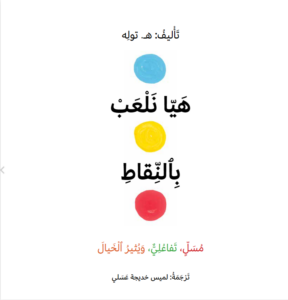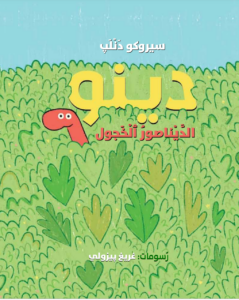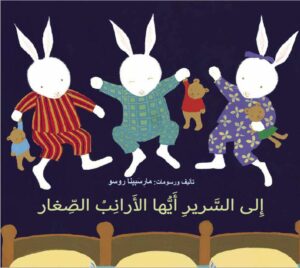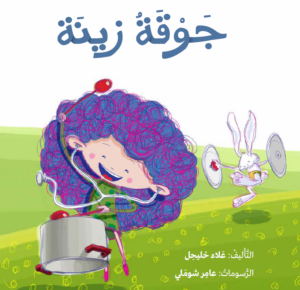Let’s talk...
About the sense of capability as children mimic the movements of various animals. We can talk to our child about tasks they can now accomplish that they couldn’t before. We can also boost their sense of capability by saying, “Yes, you can!”
About play: The book is interactive and encourages movement and play. We can talk with our child about the games they enjoy and introduce them to games we used to enjoy in our childhood.
Let’s enrich our Language...
The book is rich with action verbs and body part names like arms, legs, feet, neck, etc. We can facilitate their use in our daily lives to describe body parts and movements, encouraging the child to describe their actions.
Let’s explore...
We can explore different sources for information about the animals mentioned in the book: their types, food, and living habits. Also, we can enjoy watching a documentary with our child.
Let’s create...
The book employs the well-known collage technique of the illustrator Eric Carle, creating a beautiful composition of cutouts, fabrics, newspapers, and household materials.
Let’s play...
We can play the “Animal Yoga” game together, mimicking the movements of the various animals mentioned in the book, and adding other animals!
Let’s Talk
- During the first reading, we participate with our child as we follow instructions together. This helps our little one to understand actions through our embodiment and imitation.
- About emotions: we can ask our child how they felt when we read the book and played together, and which books they love and prefer.
- About playing together: we can ask our children which activities and games they like to play together.
Let’s Create
Children learn the art of pointillism and create paintings using this technique. We can use felt-tip pens, cotton swabs, and paint.
Let’s Enrich our Language
- The book is rich in vocabulary and linguistic concepts, touching, pressing, softening, illuminating, and more. We can explain these to our children during reading and use them in daily life.
- We can recall encouraging words from the text and try to use them in our daily lives.
Let’s Play and Have Fun Together
We can play “The King Says:” participants must follow the instructions preceded by the phrase “The King Says.” For example, if we say, “The King says jump to the right,” we jump together. If we say “Jump to the right” only, we don’t jump. We can take turns as a
Let’s Explore
The book presents the art of color blending and mixing. We can mix colors together and learn about new colors.
We can read...
We can read the title of the book together, and talk about the meaning of the word “shy.” What clues do we have of Crunch’s shyness on the cover?
The book allows...
The book allows us to sing with our child and address Crunch in different tones of voice. It also helps our child fall asleep quietly after finishing and closing the book.
How else can we...
How else can we help Crunch to feel more comfortable and communicate with us?
Many of us...
Many of us – old and young – are naturally shy people, and in some social situations we feel a desire to “disappear.” We can design a “disappearing cap” with our child and take turns wearing it. We can then talk about situations in which we feel shy. What can help us deal with our shyness in these situations?
How do we build...
How do we build a friendship with a shy child in kindergarten? We can encourage our c- We might like to paint on stones, as Crunch did. Together, we can search for the right stones and the right colors.hild to think about practical ways to do so.
The repetitive sentences...
The repetitive sentences in the text allows the child to take a greater part in telling the story. We can stop reading and let the child enjoy repeating these sentences: “What is this noise? It seems that the little bunnies have gone out of bed” or “at night we do not ride the rails nor play with the train…”
Why do bunnies play...
Why do bunnies play at bedtime? Maybe they find it difficult to fall asleep, or to leave their toys It
We can chat...
We can chat with our child about sleeping rituals that he loves (for example: reading a bedtime story or playing together with a toy they love). We may wish to share with them what we like to do in the evening to relax after a long day. This conversation helps reinforce the child’s sympathy and understanding of the parents’ need to rest and to finish their own affairs after the children sleep.
Good night, sweet dreams...
“Good night, sweet dreams,” the parents tell their little bunnies. What pre-sleep greetings do we use in our family? Which do we use in the morning? It is fun to create special greetings with our child that we can exchange with the rest of the family.
We can use...
We can use the drawings to keep track of the games that the bunnies play. Which games does our child like? And which ones do they want to play with us? Let’s play together!
guess the soun
The first time we read the book, we can stop on the last page (16) and encourage our child to guess the source of the sound.
We can take a tour...
We can take a tour around the house, and listen to the sounds emanating from each room, and try to define it: is it a rattle, a tick, or a buzz? We can also listen to the voices outside: How do the sounds coming from outside differ from the ones inside?
We may search...
We may search with our child for other items in our near environment that complement the song of Zena, such as: brrring, brrring/…it rings. We may add new sounds that match the objects we find, and form a choir like Zena’s!
When reading the book...
When reading the book for the first time, you might want to illustrate with your body the activity verbs mentioned in the book, i.e. bending, spinning, etc. It will help the child to understand the verbs.
The author uses...
The author uses verbs to talk about dancing (bend down, spin around…), and draws parallels between the children’s body and the movements, or nature that surrounds the child (the tree, silk curtain and the butterfly…). We can encourage children to look around at what surrounds them and to add more things that can look like our body in motion.
We might want...
We might want to dance with our children to songs they like in front of the mirror, and explore new moves we can do with our body! What verbs describe these moves?
When do we dance?...
When do we dance? With whom do we like to dance with? This is an opportunity to have a conversation with our child, regarding the feelings that make us dance and the social occasions that we dance at.
The last illustration...
The last illustration in the book shows a boy sitting on a dancing wheelchair, an interesting choice by the illustrator. We can talk about the different ways of dancing that people around us do according to their abilities (such as the old grandfather who uses his stick to dance).
What about having...
What about having a dancing event and invite older and younger siblings? Everyone can show their talents, dancing Dabke, belly dancing or any other dancing type.
 From My Head to My Toe
From My Head to My Toe  We Play with Dots
We Play with Dots  Crunch the Shy Dinosaur
Crunch the Shy Dinosaur  The Bunnies are not in their beds
The Bunnies are not in their beds  Zena’s Band
Zena’s Band  I Want to Dance
I Want to Dance 
